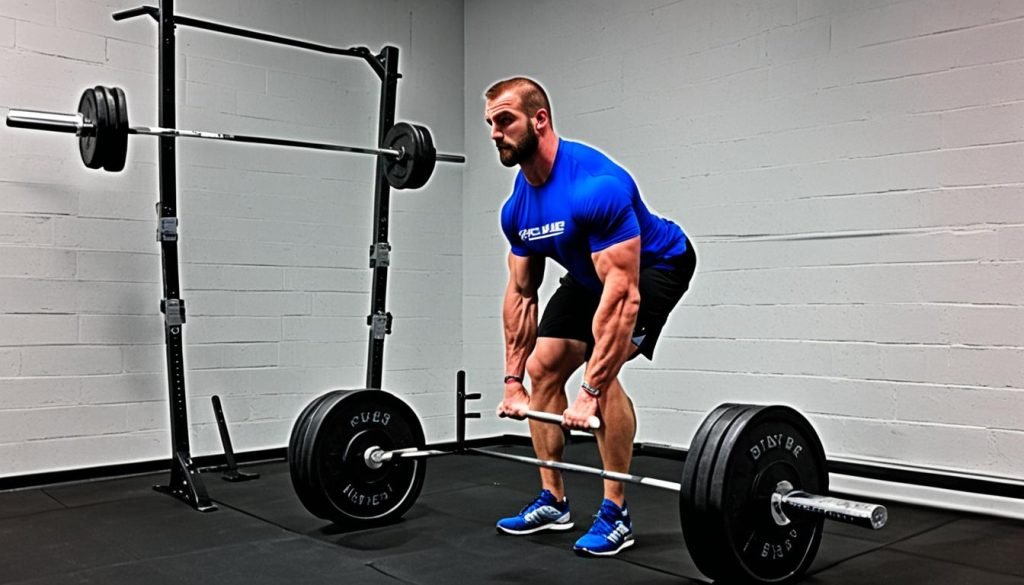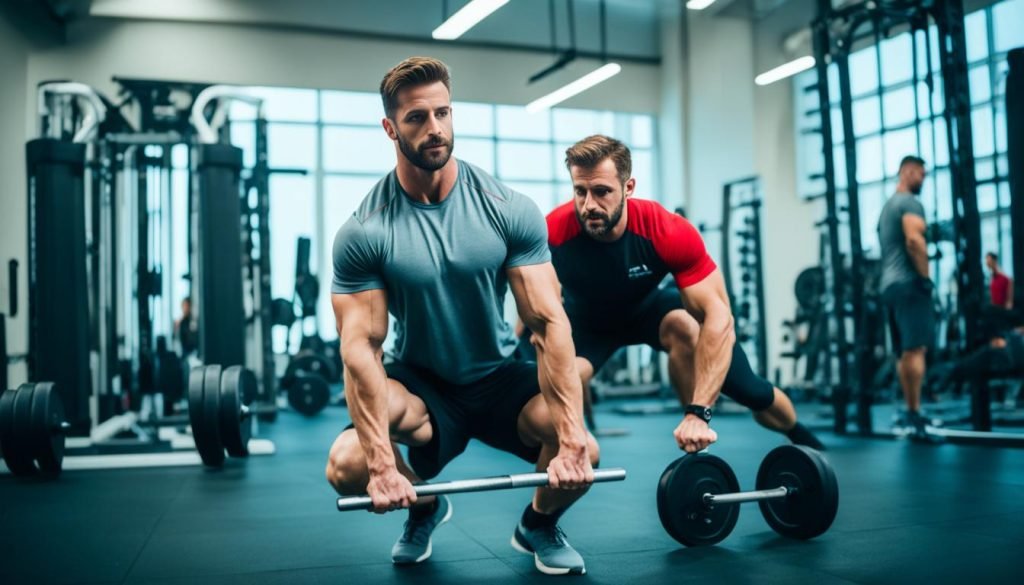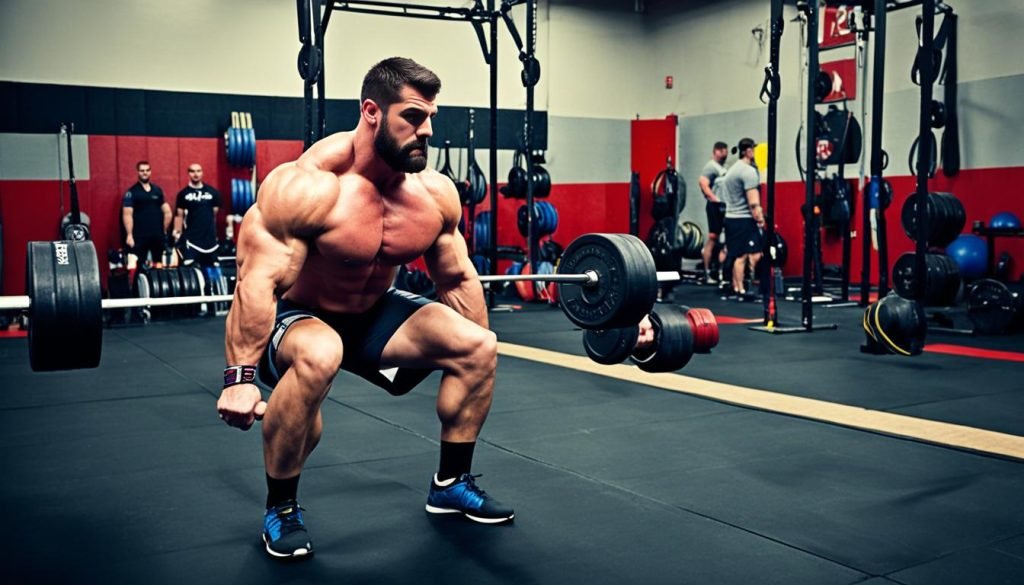Ever wondered why the deadlift is called the king of strength training? It's a key move that checks your overall strength. Learning the right way to deadlift can change your workout and how you see fitness. This guide covers the key parts of deadlift form and technique. It helps you lift safely and correctly.
Key Takeaways
- The deadlift is a fundamental exercise for overall strength.
- Proper deadlift form is crucial for maximizing benefits and preventing injuries.
- Understanding the mechanics of deadlifts enhances workout efficiency.
- Different variations of deadlifts can target specific muscle groups.
- Safety considerations should always be a priority when lifting.
Understanding the Deadlift
The deadlift is a key exercise in strength training. It's important to understand this lift to boost your workouts and fitness. Knowing what a deadlift is and seeing it as a compound exercise helps improve your skills and results.
What is a Deadlift?
A deadlift lifts a heavy load from the ground to hip level. You can use barbells, dumbbells, kettlebells, or trap bars. It's not just about strength; it's like lifting groceries or furniture, which we do every day. Learning the right way to deadlift helps you get stronger and lowers injury risk.
Deadlift as a Compound Movement
The deadlift is a compound exercise that works many muscles at once. It targets the glutes, hamstrings, quads, and core. This full-body workout boosts strength and functional fitness. It's great for bodybuilders, powerlifters, and anyone looking to improve their fitness.
| Deadlift Elements | Details |
|---|---|
| Type of Exercise | Compound Exercise |
| Main Movement | Lifting from ground to hip level |
| Muscles Targeted | Glutes, Hamstrings, Quads, Core |
| Common Equipment | Barbell, Dumbbell, Kettlebell, Trap Bar |
| Functional Benefits | Enhances daily lifting activities |
Proper Way to Do Deadlifts
Learning the right way to do a deadlift is key for getting stronger and staying safe. This guide will walk you through the steps for correct deadlift form. It also shares important cues to improve your deadlift technique.
Step-by-Step Instructions for Deadlift Technique
To do a deadlift right, follow these steps:
- Stand with your mid-foot right under the barbell.
- Make sure your shins touch the bar and grip it with your hands shoulder-width apart.
- Bend your knees so your shins line up with the bar. Lift your chest and keep your spine neutral.
- Breathe deeply, tighten your core, and push through your heels to lift the bar.
- Keep the bar close to your legs during the lift for stability.
Key Deadlift Cues for Success
Using certain cues can greatly improve your deadlift form and technique:
- Engage Your Core: This helps with support and stability.
- Drive Through Your Heels: This helps use your back muscles well.
- Keep the Bar Close: Keeping the bar near your legs reduces strain on your back.
- Maintain a Neutral Spine: A neutral back helps prevent injuries.
- Rotate Shoulders Back: This helps with alignment and works your upper body muscles.

Deadlift Muscles Worked
The deadlift is a key exercise that targets muscles in both the lower and upper body. Knowing which muscles are worked can make training more effective and lead to better results. This exercise requires engagement from many muscle groups, making it essential for building strength.
Lower Body Engagement
The main muscles used in deadlifts are the glutes, hamstrings, and quadriceps. Together, they help you lift the weight. The glutes give the power, while the hamstrings and quadriceps keep your body stable.
Strengthening these muscles boosts your lower body strength. This is important for sports and everyday activities.
Upper Body Involvement
Deadlifts also work important muscles in the upper body. The back muscles, like the trapezius, rhomboids, and erector spinae, help keep your posture right. These muscles are key for managing the weight during the lift.
| Muscle Group | Primary Muscles | Role in Deadlift |
|---|---|---|
| Lower Body | Glutes, Hamstrings, Quadriceps | Generate force to lift weight and stabilize movement |
| Upper Body | Trapezius, Rhomboids, Erector Spinae | Support posture and manage weight during the lift |
Deadlift Benefits
Deadlifts bring many benefits to fitness and wellbeing. They make people want to add this key lift to their workouts.
Building Total-Body Strength
Deadlifts are great for building strength all over the body. This total-body exercise works out muscles like the glutes, hamstrings, back, and core. Doing deadlifts makes muscles grow and get stronger. It also makes the nervous system stronger, letting people lift heavier weights.
Improving Everyday Functionality
Adding deadlifts to your routine boosts functional strength. This means doing everyday tasks becomes easier, like lifting heavy things or playing sports. Deadlifts mimic real-life actions, improving posture, stability, and sports performance. Both athletes and regular people get better at moving and living actively.

| Benefit | Description |
|---|---|
| Total-Body Strength | Engages multiple muscle groups for overall muscular development. |
| Functional Strength | Enhances the ability to perform daily activities with ease. |
| Core Stability | Strengthens core muscles for better posture and balance. |
| Injury Prevention | Improves body mechanics and reduces the risk of injuries. |
Deadlift Safety
It's key to know how to stay safe when doing deadlifts. This exercise is powerful but can be risky if not done right. Learning the right way to lift can make it safer and better for you.
Common Safety Concerns
Deadlifts can hurt your lower back if you don't lift correctly. This happens when people round their backs or stretch too far. Keeping your back straight is crucial to avoid injury and lift safely.
Tips for Avoiding Injury
There are ways to make deadlifts safer and lower the chance of getting hurt. Here are some important tips:
- Warm up well before lifting to get your muscles ready.
- Keep your back straight during the lift.
- Use your core muscles for stability.
- Keep the barbell close to your body.
- Choose a foot position that feels right for you.
- Slowly add more weight as you get stronger.

Putting safety first in deadlifts means using the right techniques and knowing the risks. Being careful and informed helps you lift safely and successfully.
Deadlift Variations and Accessories
Deadlifts can be made more effective with different variations and accessories. These tools help target specific muscles and make lifting safer and more enjoyable. Strength training tools also boost strength and performance while lowering injury risks.
Popular Deadlift Variations
There are various deadlift styles for different fitness levels and muscle groups. Key variations include:
- Sumo Deadlift: This style uses a wider stance to focus on the inner thighs and glutes.
- Romanian Deadlift: It targets the hamstrings and lower back, improving flexibility and strength.
- Trap Bar Deadlift: This variation helps maintain an upright posture, reducing back strain while working the legs.
These deadlift styles offer adjustments for different training goals. Whether you want to build muscle or increase explosiveness, there's a style for you.
Essential Deadlift Accessories
Adding certain accessories to your deadlift routine can improve performance and safety. Here are some key tools:
- Belt: Offers support and stability for heavy lifts.
- Straps: Enhance grip strength, letting you lift heavier weights without grip issues.
- Blocks: Elevate the bar for easier starting positions, helping with better form.
These accessories are great for any strength training plan. They help lifters reach their full potential.

Conclusion
Learning how to do deadlifts right is key for building strength. This summary shows why it's important to know the movement's mechanics and the muscles it works. By focusing on both the lower and upper body, you can get the most out of deadlifts.
Adding deadlifts to your workout routine helps develop your whole body and makes everyday tasks easier. Knowing different deadlift techniques and using the right gear can make your workouts better and safer.
With the right technique and a balanced approach, deadlifts can be a key part of your strength training. This powerful exercise improves your physical abilities and makes your fitness journey more rewarding.
FAQ
What equipment do I need to perform a deadlift?
You can use a barbell, dumbbells, kettlebells, or a trap bar for deadlifts. Each piece of equipment has its own benefits. Choose based on your training goals.
What are the common mistakes to avoid during a deadlift?
Don't round your back, use the wrong grip, or forget about hip positioning. Keep your spine neutral and engage the right muscles for a proper lift.
How often should I incorporate deadlifts into my workout routine?
Deadlifts should be part of your routine 1-2 times a week. Make sure you have enough rest time to recover.
What muscles are primarily targeted during a deadlift?
Deadlifts work on the glutes, hamstrings, quadriceps, and lower back. They also engage stabilizing muscles for strength.
Can deadlifts help improve my athletic performance?
Yes, deadlifts boost total-body strength, power, and stability. This can improve your performance in sports and daily activities.
What are some variations of deadlifts that I can try?
Try sumo deadlifts, Romanian deadlifts, and trap bar deadlifts for variety. Each variation targets different muscles and adds new challenges to your routine.
Are there specific accessories I should use when performing deadlifts?
Use weightlifting belts, chalk for grip, and lifting straps to improve your deadlifts. They help stabilize your core and boost grip strength.
What are the benefits of adding deadlifts to my workout?
Deadlifts build total-body strength, improve posture, and enhance functional fitness. They also help with muscle growth and fat loss.
How can I progress with my deadlift training?
Increase the weight, change your training volume and frequency, and try different variations or accessories. This will challenge your muscles and help you improve.
Source Links
- Deadlift with Proper Form: (Guide to Deadlifting Safely_ – https://www.nerdfitness.com/blog/strength-training-101-the-deadlift/
- How to Do a Deadlift the Right Way for Stronger, Safer Workouts – https://www.menshealth.com/fitness/a26568968/deadlift-form/
- How to Deadlift with Proper Form: The Definitive Guide | Stronglifts – https://stronglifts.com/deadlift/
Recent Posts
It's important to evaluate whether Beachbody On Demand continues to meet your fitness needs as we enter 2025. With a range of workout programs and nutrition plans, the platform claims to cater to...
Just like having a personal trainer at your fingertips, Beachbody On Demand offers you an extensive library of on-demand workout programs accessible anytime, anywhere. This service allows you to...

